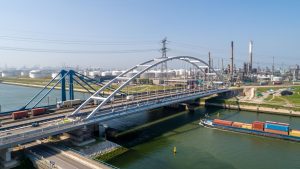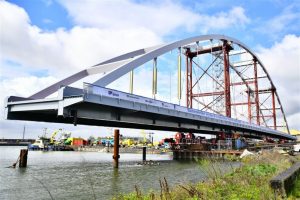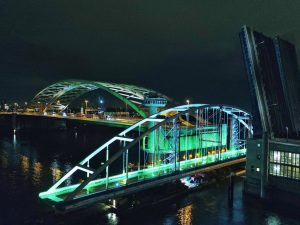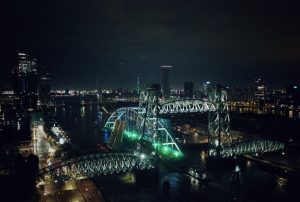In order to guarantee the availability of the Suurhoff traffic connection on the A15 within the Rotterdam Maasvlakte area until at least 2032, Rijkswaterstaat has commissioned construction consortium STIPT to realize the Temporary Connection Suurhoff Bridge. STIPT is a partnership between the companies Besix, Dura Vermeer, Mobilis and Hollandia Infra.
The contract mainly concerns the installation of an all-steel arch bridge with 2 lanes for road traffic and a separate bicycle path. The new bridge will have a total span of 200 meters, will be 20 meters wide and approximately 40 meters high. The new river crossing over the busy Hartel Canal will weigh approximately 2,500 tons.
As soon as the new arch bridge has been placed and taken into use, the construction consortium will also renovate the existing bridge from 1974 in various phases. This concerns the renovation of the cover plate of the existing Suurhoff Bridge and the redesign of the lanes.
New temporary connection
The scope of work for Hollandia Infra within the construction consortium mainly includes the design, manufacture and assembly of the steel arch bridge with the joint transitions on either side of the steel bridge and the supports under the steel bridge. The project is technically a complex challenge because many stakeholders are involved, including BP (British Petroleum), RWS, Port of Rotterdam Authority, Prorail and local residents. The new steel arch bridge is a temporary connection and is expected to serve for approximately 10 to 15 years, next to the existing, then renovated Suurhoff Bridge. The bridge is designed for a lifespan of 100 years and designed in such a way that the bridge will be transportable in the future.
History
The Suurhoff Bridge is an important link between the Maasvlakte and the western part of Voorne-Putten on the one hand and the Botlek, Europoort and Rotterdam on the other. The bridge crosses the Hartel Canal and is located on the A15. It is the only connection to the Maasvlakte and therefore indispensable for the Rotterdam port area and the rest of the Netherlands. Due to the increase in (heavy) freight and passenger car traffic, the bridge from 1974 needs to be replaced. To this end, the existing bridge from 1974 will be renovated and adapted to two lanes in the direction of the Maasvlakte, Brielle and Westvoorne. The new temporary bridge to be built has two lanes for one direction of traffic to Rotterdam. In addition, the new bridge will have a bicycle path in two directions. Both bridges will be connected to the A15.
The Suurhoff Bridge is one of 13 bridges in South Holland that will be renovated and renewed in the coming years as a Replacement and Renovation (V&R) project. An exploration is currently underway into a completely new connection that should be ready around 2030.
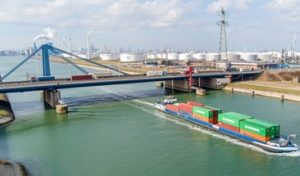

Photos: the old situation (left, RWS/Paul van Baardwijk) and the new situation with the Temporary Suurhoff Bridge next to the existing bridge (right, artist impression STIPT)
Construction combination & Total project
STIPT is proud that we can carry out this assignment and we see collaboration as the foundation for a predictable and reliable project realization. That means collaboration in every phase and every aspect of the construction: from design to implementation, from safety to support in the environment,” says Ernst Mol of STIPT. “By opting for a bridge with a 200-metre span, we build smarter, we minimize interfaces and our planning is robust.”
The assignment for construction consortium STIPT mainly consists of:
• the construction of a new bridge for HRR road traffic on the A15 and a bicycle path to relieve the existing Suurhoff Bridge;
• repair of the existing bridge and redesign of HRL of the A15;
• adapting the A15 to new alignments;
• taking integration measures.
Collaboration as a foundation
Rijkswaterstaat awarded this contract on the basis of a combination of quality and price, whereby the collaboration between client and contractor was part of the tender. By opting for a bridge with a span of 200 meters, smarter construction is possible, hindrance during construction is limited, interfaces are minimized and the planning is robust.
Sustainable solution
The Temporary Connection Suurhoff Bridge can be called a sustainable bridge for several reasons:
- By choosing a longer bridge, the bridge piers are built on land instead of in the river. This resulted in cost savings as well as less hindrance for shipping/land traffic.
- The bridge is expected to serve as a Suurhoff Bridge for 10 to 15 years. However, the bridge can last much longer. By opting for a steel bridge, the entirety of the bridge can be moved to another location for use again. A steel driving deck is light, easy to handle and therefore favorable for future reuse. If this does not work, the bridge can still be melted down, in other words it is 100% recyclable.
- The bridge is entirely manufactured at a conditioned location, namely the well-equipped production halls of Hollandia Infra, and transported from here to the construction site in one piece. This results in less environmental impact on the construction site.
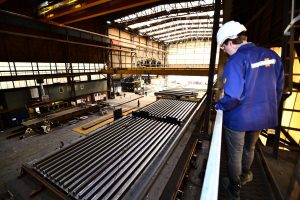
Scope Hollandia Infra
The core activities of Hollandia Infra within the scope of the project are designing, manufacturing, preserving, assembling and assembling:
- 1 steel arch bridge 200 meters long, 20 meters wide and 2500 tons heavy;
- joint transition on both sides of the steel bridge;
- bearings under the steel bridge.
Scope Hollandia Services
The core activities of Hollandia Services within the scope of the project are:
• remove existing bridge keeper’s house;
• removing and installing foot plates guide rail/barrier existing bridge;
• repair cracks B1 and perform Inserts B4 in the existing bridge;
• remove barrier gates/boxes, pre-warning signals, etc.;
• as additional work, Hollandia Services will carry out an innovative reinforcement of the trap. A steel plate is glued to the existing trap by means of epoxy.
Design
Hollandia Infra designed the alternative bridge in close collaboration with STIPT’s contractors. The existing Suurhoff Bridge is a heavily ridden bridge. Approximately 9 to 10 million motor vehicles pass through the traffic connection every year. Due to the large amount of freight traffic that travels over the bridge, the quality requirements for the new bridge are high. This high load requires thick steel. Steel plates with a thickness of between 12 and 80 mm were used for the new temporary bridge. The steel plates for the beams are 80mm thick, the cover plates measure 20mm. Welding these thick plates also requires special craftsmanship from the welders of Hollandia Infra. The Suurhoff Bridge is an all-steel bridge with an orthotropic driving deck. The so-called centre-to-centre distance between the main beams is 13.4m. The sheet material used is in steel quality S355J2+N with a sheet thickness, as indicated above, up to 80 mm thick. The steel is provided with a 3-layer preservation system. The lane for cyclists is constructed from a reinforced plastic deck next to the main girders.
Photo: the new Temporary Suurhoff Bridge, drone photo by Paul van Baardwijk in order of Rijkswaterstaat
Dimensions
The new steel arch bridge has a total length of 198 meters and, including the cycle path, is approximately 17.5 meters wide and weighs approximately 2500 tons. The highest point is about 40 meters. Hollandia Infra fabricated and preserved the bridge in 4 parts of approximately 50 m each on its site in Krimpen a/d IJssel. The bridge sections were assembled on a quay near the factory, after which the bridge as a whole was sailed on 2 pontoons to the location near the construction site.
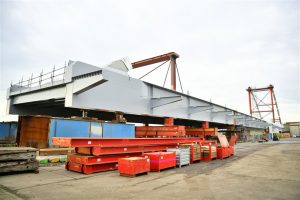
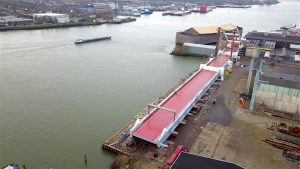

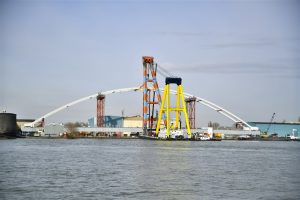
Photos: building the several parts of the bridge, photos by PortPictures
Manufacturing
At the Hollandia yard in Krimpen aan den IJssel, all sections of the new Temporary Suurhoff Bridge have been assembled into one complete bridge. For the installation of the steel arch, (welded) auxiliary constructions are used, which are placed on the bridge deck. See attached image. These pillars serve as temporary support for the arch parts of the bridge. After the bridge has entered its final location near Oostvoorne, the supporting auxiliary structures will be removed again.
Photo: the new Temporary Suurhoff Bridge, supported by auxiliary structures. Photo: PortPictures
Transport & Assembly
In the spring of 2021, the temporary Suurhoff Bridge was transported as one complete bridge on 2 interconnected pontoons from the yard in Krimpen a/d IJssel to the Maasvlakte, right through the center of Rotterdam. An operation that appeals to the imagination, because there are 7 bridges and 1 barrier to pass. Including guidance, the transport is about 250 meters long. In the weekend of Friday 14 and Saturday 15 May 2021, the temporary arch bridge in the A15 was placed next to the existing bridge. On Saturday evening 15 May at 21.00 the time had come and the bridge was in place.
Photos: passing the Brienenoord Bridge and the Koninghaven Bridge in Rotterdam, images: Eyecatcher commissioned by Rijkswaterstaat
Special competences
In the request specification, the client Rijkswaterstaat stated that the new arch bridge must span at least 160 meters and must not have piers in the Hartel Canal. After careful consideration, the Besix/Mobilis/Dura Vermeer/Hollandia tender team opted for a longer bridge of 200 metres. This smarter and less construction will ultimately result in significant cost savings. Because the bridge is longer, the piers are placed on land instead of in the waterway. As a result, no collision protection needs to be installed. This also ensures less nuisance for busy shipping traffic, but also for road traffic. The transport of the 200 meter long bridge in 1 piece on 2 pontoons, with a transport weight of approximately 3000 tons, is a fairly exceptional exercise in the Netherlands. Some well-known Rotterdam bridges are also passed, including the Erasmus Bridge, the Botlek Bridge and the Hartel Bridge.
Steel….the material
Due to the choice for a longer bridge in connection with the above-mentioned advantages, cost savings and less hindrance for shipping and road traffic, the choice for the use of steel was also made. A span of this size can hardly be realized in concrete.
The temporary Suurhoff Bridge in the media
The special transport does not go unnoticed in the media either. Via the links below you can view the various articles and videos:
NOS:
https://nos.nl/artikel/2380109-tweehonderd-meter-lange-boogbrug-vaart-door-rotterdam
RTV Rijnmond:
https://www.rijnmond.nl/nieuws/1210110/Suurhoffbrug-onderweg-naar-eindbestemming-bij-de-Maasvlakte
Telegraaf:
https://www.telegraaf.nl/video/1874384968/megatransport-gefilmd-brug-door-rotterdam-gevaren
AD (second part of the journey):
https://www.ad.nl/rotterdam/suurhoffbrug-vervolgt-weg-richting-maasvlakte-en-past-maar-net-door-harmsenbrug-scheelt-maar-een-paar-centimeter~a2ff1565/
Other articles about the Temporary Suurhoff Bridge:
- https://www.rijnmond.nl/nieuws/1208501/Nieuwe-Suurhoffbrug-zondag-op-transport-naar-eindbestemming-Als-het-weer-het-toelaat#
- https://www.rijnmond.nl/nieuws/204876/Nieuwe-Suurhoffbrug-bijna-klaar-voor-bijzonder-transport
Take a look at the after movie, developed by Rijkswaterstaat:
All videos that Rijkswaterstaat made about the Temporary Suurhoff Bridge can be found here:
Videos about Suurhoff Bridge | Rijkswaterstaat
More information about the Suurhoff Bridge Project:
https://www.rijkswaterstaat.nl/wegen/projectenoverzicht/a15-renovatie-en-nieuwbouw-suurhoffbrug

